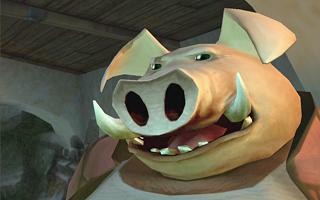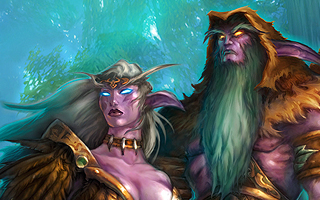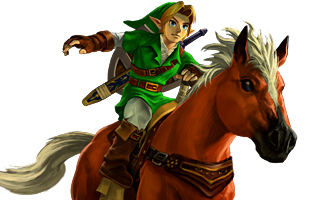Best Sequel Innovations
Top 10 Best Sequel Innovations of All Time!
It’s not unusual for video game sequels to be better than their predecessors, but this list is focused on revolutionary changes rather than incremental improvements. I’ve already recognized gaming’s best sequels elsewhere on this site, but this list focuses on specific design choices that could be seen as pivotal additions to a series. (I’ll avoid mentioning changes that were made as a result of a transition from 2D to 3D gameplay, since that topic has also been covered already.) Sequels often introduce new features and gameplay mechanics in the name of innovation, and the mechanics discussed on this page were impactful enough to redefine entire franchises. In some cases, it’s hard to believe that they weren’t included from the very beginning.
10
Force Feedback
StarFox 64

Force feedback had been used in arcade games dating back to the 1970s, but the concept wasn’t fully embraced on home consoles until 1997. StarFox 64 was one of the most highly anticipated first-generation Nintendo 64 games, and a lot of the hype was based around its graphics, cinematic presentation, and voice acting. One of the most compelling aspects about the game was that it was bundled with Nintendo’s newly-minted Rumble Pak accessory. When plugged into the N64 controller, the Rumble Pak would vibrate in response to specific events in the game. There would be a gentle rumble when you used your booster rockets, you could feel when an enemy fighter was shooting you from behind, and the intensity would be turned up even further if you crashed your starfighter. Other game companies wasted no time in embracing the concept, and force feedback became a standard feature within a single generation. Force feedback would have happened with or without StarFox 64, but it’s hard to explain how innovative the game felt at the time. StarFox 64 brought a whole new level of immersion to the world of console gaming, and its implementation of force feedback created shock waves that could be felt through the entire industry.
9
Invincibility
Wario Land II

The gameplay in the first Wario Land game and the Virtual Boy follow-up was based around unique helmets that granted Wario special abilities. This formula was changed with the release of Wario Land II. The constant threat of dying is a core mechanic in most platformers, but the Wario Land sequels broke convention by making Wario invincible. Although Wario could no longer be killed, he could still be hurt in a comical fashion. In certain situations, he could be set ablaze, inflated by bee stings, or turned into a zombie. These afflictions would normally be cause for great concern, but Wario had to take advantage of his misfortunes in order to progress through the game. For example, he might need to be flattened like a pancake in order to fit into narrow passageways. At other times, he would have to purposely fatten himself up in order to break through certain floors. The small Game Boy screen wasn’t ideal for side-scrolling platformers, but Wario Land II was built around clever puzzles rather than fast-paced action. The invincibility gimmick was abandoned by the time Wario Land 4 was released, but this makes the two games that used it seem even more special in retrospect.
8
The Manual
Tony Hawk’s Pro Skater 2

Tony Hawk’s Pro Skater 2 featured the same open-ended gameplay that its predecessor was known for, but it built upon the original in several ways. Many features that would become staples in the series were first seen in Tony Hawk 2 – including the “Create-a-Skater” and “Create-a-Park” modes. The game also introduced several new tricks (including the noseslide, tailslide, bluntslide, noseblunt, feeble, and overcrook grinds), but the most significant addition to the game was the introduction of the manual technique. This maneuver effectively enabled players to string various tricks together and form a near-infinite number of combos. Ultimately, this new dynamic contributed greatly to the game’s replay value. The first Tony Hawk game was well-received, but the sequel caught everyone off guard and was labeled one of the greatest games of all time. The game received perfect scores from countless gaming outlets and was honored with numerous “Game of the Year” awards. Activision eventually ran the series into the ground, but they definitely got it right with Tony Hawk’s Pro Skater 2.
7
Grappling Hook
Just Cause 2

The first Just Cause let players experiment with a plethora of weapons, but the most interesting was the grappling gun that could latch onto nearby vehicles. The game itself received mixed reviews, but the response to the grappling hook was so positive that the development team decided to make it an essential part of the sequel’s combat system. The grappling hook was more accessible and easier to use in Just Cause 2, and players could now use it to pull themselves to any solid surface. The weapon rewarded creativity and could be used for variety of purposes. You could scale buildings, catch a ride on a moving vehicle, or use the grappling hook to attach two enemy soldiers together. The weapon was useful for both combat and navigation purposes, and its potential uses were limited only by your imagination. (Attaching an enemy to an exploding barrel and sending him flying into the air is a lot more entertaining that simply shooting him.) Just Cause 2 was one of the largest open-world games ever created, and it was a blast to explore thanks to the grappling hook. For obvious reasons, the grappling hook was also a focal point of Just Cause 3.
6
Co-Op Mode
Portal 2

Portal was one of the most inventive games of its era, but it’s difficult to be consistently creative. Portal 2 kept things fresh with new features like tractor beams, light bridges, and elements that could increase the player’s speed or improve their jumping abilities. These additions allowed for more complex puzzles to be included in the single-player campaign, but this added layer of complexity was most obvious when playing with a second player. The new cooperative levels in Portal 2 relied heavily on communication and coordination, and the puzzles were much more difficult than the ones designed for a single player. Most co-op games simply allow multiple people to play at the same time, but Portal 2 is one of those rare exceptions where cooperation is absolutely necessary in order to progress. Valve had experience with co-op gameplay – Team Fortress 2 being an obvious example – but it was pretty amazing how they were able to implement a co-op mode into a series that was not originally based around the concept. Portal was a hard act to follow, but the co-op gameplay made its sequel feel every bit as imaginative.
5
Copy Ability
Kirby’s Adventure

Kirby’s Dream Land was a charming game that launched one of Nintendo’s most beloved franchises, but it’s not unfair to describe the game as one-dimensional. Kirby could inhale his enemies or inflate himself up like a balloon, but the game lacked any real depth beyond those basic mechanics. Beginning with Kirby’s Adventure, Kirby was given the capacity to copy his enemies’ abilities after inhaling them. There were dozens of unique abilities for Kirby to experiment with, and this allowed him to do all sorts of amazing things – like breathe fire or pilot a UFO. In subsequent games, Kirby could also copy the appearance of his enemies in addition to stealing their abilities. Copy abilities have been a staple in the Kirby franchise since their introduction, and they are even present in the Super Smash Bros. series! The copy ability made Kirby gaming’s most versatile heroes this side of Mega Man, and it’s hard to play the original Kirby’s Dream Land without feeling like something’s missing.
4
8-way Run
SoulCalibur

SoulCalibur was originally released in arcades in 1998 before being ported to the Dreamcast the following year with improved graphics and new features. It picked up numerous “Game of the Year” awards and received critical acclaim for bringing numerous innovations to the fighting game world. The most significant innovation was the inclusion of the 8-way run. In Soul Edge (and most other 3D fighting games), movement on the z-axis was mostly restricted to evasive maneuvers. Players could sometimes roll out of the way or sidestep an attack, but the gameplay wasn’t as three-dimensional as the graphics were. In contrast, the 8-way run in SoulCalibur gave players much more control over their positioning. They could move around their opponent, set up counterattacks, or use the environment to their advantage. In short, the 8-way-run added a much-needed sense of freedom and allowed for more strategies to be implemented. Soul Edge was a great game in its own right, but Namco decided to give the sequel a new name in order to start fresh. They aimed to take the series in a new direction with SoulCalibur, so it’s appropriate that they built the game around the new movement system. The 8-way run defined SoulCalibur and its sequels, and Soul Edge feels archaic in comparison.
3
Active Time Battles
Final Fantasy IV

Final Fantasy IV improved upon its predecessors in several meaningful ways. As the first 16-bit entry in the series, the game obviously looked and sounded better than previous entries, but its most significant innovation was the brand new “Active Time Battle” (ATB) system, which added oceanic depth to the typical turn-based battles that the genre was known for. Requiring players to battle in a real-time environment introduced an element of urgency, and this had profound effects on strategy and the overall pacing of the game. Final Fantasy is a series that is constantly reinventing itself, and each entry feels radically different from the last. That being said, the ATB system made such an impact in Final Fantasy IV that it was used in many subsequent Final Fantasy games and other notable RPGs like Chrono Trigger. The golden age of JRPGs was defined by the ATB system, and variations of it were still being used decades after it was initially conceived. The importance of the ATB system to the Final Fantasy series cannot be overstated.
2
Online Multiplayer
Halo 2

Halo 2 improved upon the original in many ways, but the ability to compete against other players via Xbox Live defined the experience for many. Halo 2 wasn’t as innovative as the original, but the inclusion of online play could be viewed as a pivotal moment for the series. The multiplayer component is the bread and butter of the Halo series, and the franchise is likely the first thing that comes to mind when you think of Xbox Live. Halo: Combat Evolved was a genre-defining game in its own right, but the sequel’s online component helped further legitimize console-based first-person shooters. Halo 2 wasn’t the first game to support Xbox Live, but it was the most popular game on the service for many years. Some contend that Halo: Combat Evolved provided a more complete single-player experience, but Halo 2 outsold it on the back of its online gameplay. For better or for worse, Halo 2 kick-started the trend of companies favoring multiplayer games over robust single-player campaigns. Online gameplay was an inevitability rather than a creative breakthrough, but there’s no denying that Halo and Xbox Live fit together like Turner and Hooch.
1
Combos
Street Fighter II

I’ve already recognized Street Fighter II as gaming’s greatest sequel, and the inclusion of combo attacks is one of the main reasons why the game was so successful. Special moves were notoriously difficult to perform in the first Street Fighter to the point that it almost seemed like you needed luck on your side if you wanted to pull them off consistently. The developers made the timing more lenient in the sequel in order to make the special moves easier to perform, and this had unintended side effects. Incidentally, giving players more time to enter commands also made it possible to string other attacks together. Certain moves flowed naturally into one another, so combo attacks felt completely intuitive even though they were not originally planned. This accidental combo system became one of the defining traits of Street Fighter II, and the concept was expanded upon and further incentivized in subsequent installments of the series. More significantly, the entire industry embraced the concept and similar combo systems were adopted as a standard feature in the fighting genre. Some of the best things in life are unplanned, and this is obviously true in the video game industry.





Do you agree with this list? Let us know what you think by leaving a comment below. Your opinion matters!